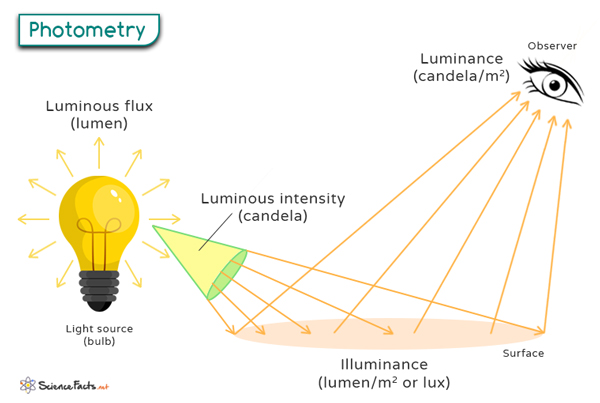Photometry
Photometry is the precise measurement and study of visible light, which is perceived as brightness by the human eye. It quantifies light and contextualizes it within the limits of human vision, considering factors like brightness, color, and perceived intensity. Photometry focuses specifically on the spectral range that the human eye can detect and interpret, spanning wavelengths roughly between 380 and 740 nanometers.
Photometric Quantities and Units
A photometric quantity refers to any measurable property of light that can be perceived by the human eye. There are several photometric quantities and these are listed in the table below.
| Photometric Quantity | Definition | Photometric SI Unit (Symbol) |
|---|---|---|
| 1. Luminous Energy | Quantifies the visual impression of light by measuring its energy | Lumen second (lm∙s) or Tablot |
| 2. Luminous Flux | Total amount of visible light emitted by a source in all directions, or luminous energy per time | Lumen (lm) |
| 3. Luminous Intensity | Power emitted by a light source per unit of solid angle in a specific direction, or luminous flux per solid angle | Candela (cd) |
| 4. Illuminance | Total luminous flux incident on a surface per unit area | Lux (lx) |
| 5. Luminance | Luminous flux per unit solid angle per unit projected source area | Candela per square meter (cd/m²) or Nit |
| 6. Luminous Exitance | Total amount of visible light leaving a point on a surface in all directions above the surface, or luminous flux per unit area | Lumen per square metre (lm/m2) |
| 7. Luminous Exposure | Total luminous energy incident on a surface per unit area | Lux second (lx∙s) |
| 8. Luminous Efficacy | Measures how well a light source produces visible light. It is defined as the ratio of luminous flux to power consumed by the light source. | Lumen per watt (lu/W) |
Photometer
A Photometer is a device designed to measure various photometric quantities accurately. It quantifies and assesses light in ways that align with human perception. Photometers are instrumental in fields where precise light measurements are crucial, such as lighting design, research, and quality control.
Types of Photometer
- Luminance Meter: It measures luminance and is typically used for evaluating the brightness of surfaces or displays.
- Illuminance Meter: It measures illuminance by assessing the light intensity on a surface, ensuring adequate levels for visibility or specific tasks.
- Spectrophotometer and Colorimeter: These devices analyze the spectral characteristics and color of light, allowing for detailed assessments of color rendering and consistency.
Working Principle of a Photometer
Photometers function by observing how various wavelengths of light are either reflected or absorbed by these materials. Their primary operation is the conversion of light into an electric current, allowing the intensity of the light to be measured based on the resulting electric current.
When light passes through a colored solution, specific wavelengths are absorbed, producing an absorption spectrum. The point at which maximum light absorption occurs is identified as the absorption maximum. Conversely, the wavelengths that are not absorbed are transmitted through the solution, giving it its characteristic color.
The transmittance (T) can be calculated by taking the ratio of emergent light’s intensity (IE) to that of incident light’s (Io).
T = IE /Io x 100%
Some photometers operate by directing a beam of white light at a surface and measuring the amount of light reflected back. This method helps determine the surface’s reflective properties.
Applications of Photometry in Various Fields
- Science and Technology: In fields like physics and engineering, understanding how light behaves and how humans perceive it is crucial for designing efficient lighting systems, displays, and optical devices.
- Architecture and Design: Architects and lighting designers rely on photometry to create well-lit spaces that enhance functionality, aesthetics, and energy efficiency.
- Astronomy and Astrophysics: Photometry aids in measuring the brightness of celestial objects, determining distances in space, and studying the behavior of light across vast cosmic distances.
- Medicine and Biology: Photometry is pivotal in ophthalmology by evaluating vision and eye health. Moreover, photobiology explores how light impacts living organisms at a cellular and molecular level.
- Everyday Life: From TV screens to the bulbs illuminating our homes, photometry underpins the technology and lighting solutions we interact with daily.
-
References
Article was last reviewed on Saturday, May 25, 2024










Regarding the section titled “Applications of Photometry in Various Fields” – Artists rely on Photometric Value Scales to judge the appropriate amount of light reflectance in various areas of their painted subject.
While not necessarily a scientific application, the values were derived from photometry studies, suggesting that art is another “Application of Phtometry…”.